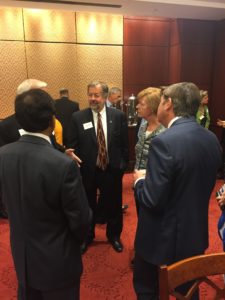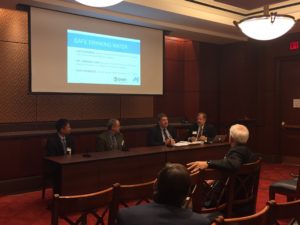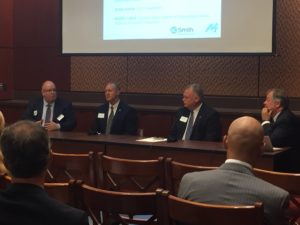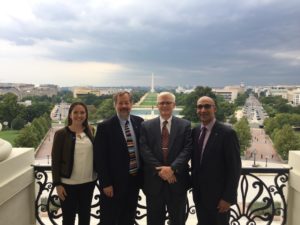WASHINGTON, D.C. WATER POLICY EVENT SUMMARY
 By: Dean Amhaus, President & CEO, The Water Council
By: Dean Amhaus, President & CEO, The Water Council
On September 6, 2017, we had the pleasure of partnering with A. O. Smith Corporation, world-leading manufacturer of water heaters and boilers headquartered in Milwaukee, to host our first water policy event in Washington, D.C. at the U.S. Capitol called “Fostering Public-Private Innovations in the U.S. Water Market – Wisconsin’s Leadership” (agenda).
Joined with Rich Meeusen, co-chair of The Water Council and CEO of Badger Meter, we had meetings and conversations with members of the Wisconsin U.S. Congressional delegation including Speaker of the House Paul Ryan (R), U.S. Senators Ron Johnson (R) and Tammy Baldwin (D), U.S. Representatives Sean Duffy (R), Mike Gallagher (R) and Mark Pocan (D) as well as with the Special Assistant to the President on Infrastructure, DJ Gribbin, to share how entities in Wisconsin’s water tech cluster can assist the federal government and their constituents.
Our collective message from Wisconsin was that as the Administration and Congress considers legislation to address our nation’s infrastructure issues they cannot ignore the significance of the water, wastewater and storm water systems in our country. Besides the importance of utilizing the technologies of our companies, expertise of our cluster’s utilities and the research strengths of our academic programs, we also urged officials to consider how watershed management programs could cross over political districts to focus on watersheds boundaries. We all know very well that water knows no boundaries; it will flow into a Democrat or Republican basement or, because of a draught, not exist no matter the political lines.
Key takeaways from our meetings:
- Strong emphasis on the President’s infrastructure plan with water acknowledged as one of the key components.
- Affordable products and services are needed, both high-tech and low-tech.
- Emphasis on incentive based funding models and innovative, public-private funding models.
- Open to ideas on how to develop a federal infrastructure plan that can be utilized at the state and local levels.
- Overall awareness and enthusiasm for what the Wisconsin cluster is accomplishing, and encouragement to continue developing solutions and stay connected with our elected officials.
We are confident our story was heard, and equally as important, our leaders know the role that the Milwaukee region is playing in the global water market. We look forward to continuing the lines of communication with our elected officials.

FOSTERING PUBLIC-PRIVATE INNOVATIONS IN THE U.S. WATER MARKET
With over 50 attendees representing a diverse array of public and private organizations, I had the good fortune of moderating two expert panels with guests from the offices of the U.S Environmental Protection Agency (EPA) and National Science Foundation (NSF), technical experts from A. O. Smith and Water Environment Federation, entrepreneurs from PaveDrain and University of Wisconsin-Milwaukee and leaders from Milwaukee Metropolitan Sewerage District and Badger Meter.
Senator Baldwin, who generously hosted us in the U.S. Capitol, welcomed guests prior to the session and reinforced her steadfast commitment to growing water innovation opportunities in Wisconsin and continuing to create a gateway to D.C. for our cluster and members.
We also had the honor of hearing from Ajita Rajendra, CEO of A. O. Smith, who shared the story of how they identified the need for fresh, clean water around the world, and quickly acted on this by entering the water treatment product market in China in 2009. Now A. O. Smith is the leading residential water treatment brand in China, and a great example of the rapid innovation, foresight and adaptability of businesses in our region.
CONVERSATION ON SAFE DRINKING WATER
With the devastating hurricanes in the U.S., access to safe drinking water is a critical topic for people in Texas and Florida, but we must remember it is not exclusive to that. A question I posed to the panelists was what needs to occur to get technology commercialized and into the market?
Dr. Junhong Chen, who wears industry, government and academic hats in his roles with the NSF, as co-director of the Water Equipment & Policy Research Center housed by the University of Wisconsin-Milwaukee, and as an entrepreneur spoke to the NSF Industry/University Cooperative Research Center (I/UCRC) model, one that promotes cross collaboration of public and private entities.
“Universities are unique in providing new ideas, talent and research facilities. In order to bring innovation from concept to product you have to think through the entire innovation process. In order to bridge the gap, universities have the early stage technology readiness level (TRL) role, which is what the NSF program is sponsoring. In the I/UCRC engineers are working to move from level two to level six and eventually have the company take the innovation over. Industry and academic collaboration is essential and we should be rationally thinking about how we can come up with research activities to bridge the entire TRL levels from one to nine.”
While working with the I/UCRC in Milwaukee, Dr. Chen developed a sensor that allows for the rapid detection of contaminants in water sources, both commercially and in private residences. Once commercialized, he hopes families will be able to buy the sensors for their home water sources to easily test quality, and avoid potential widespread water contamination crises like that in Flint, Michigan. Also, through partnerships with utilities, the technology could allow municipalities to monitor water quality for whole cities in real-time. This would help protect public safety on the drinking water side and allow wastewater utilities to use the exact amount of chemicals or energy needed to sanitize water, instead of the current system of guessing and testing again, enabling cities to save both money and energy. However, reaching this level of commercialization is often a tough journey, since connecting school labs with capital is notoriously difficult.
 “It takes a long time to bring innovative ideas in the water industry to the marketplace. We need to think about ways to accelerate and improve the probability of success and the process,” said Dr. Chen. His sensor idea was generated in 2009 and is now in prototype phase. “There are different cultures in industry and academia. Different goals, and different practices. Industry understands that it takes time to become a product, academia needs to understand that what they’re developing will be for customers in the end. When we develop a new idea in the lab, we usually take it for granted. The reality is that that’s not true. NSF wants to sponsor customer discovery activities for professors and students to go outside the lab, interview customers and understand their pain points to align the research with the tech development, so it can be put towards something useful for the customer. We’re concentrated on leading the change.”
“It takes a long time to bring innovative ideas in the water industry to the marketplace. We need to think about ways to accelerate and improve the probability of success and the process,” said Dr. Chen. His sensor idea was generated in 2009 and is now in prototype phase. “There are different cultures in industry and academia. Different goals, and different practices. Industry understands that it takes time to become a product, academia needs to understand that what they’re developing will be for customers in the end. When we develop a new idea in the lab, we usually take it for granted. The reality is that that’s not true. NSF wants to sponsor customer discovery activities for professors and students to go outside the lab, interview customers and understand their pain points to align the research with the tech development, so it can be put towards something useful for the customer. We’re concentrated on leading the change.”
“The impact on drinking water as a result of the hurricanes are approaching devastating,” said Lee Forsgren, with the EPA’s Office of Water. “We need to get the wastewater systems back up and running. In Texas, 2,800 systems were impacted and 1,900 systems were up as of last night. Most that were out was a result of no electricity and a number of drinking water systems are still down because personnel have not been able to get to them. In an urban area you have about 1,200 different systems and are working to get the largest ones to triage immediately.”
One of President Trump’s campaign issues focused on infrastructure, and with further discussions having occurred recently I asked Mr. Forsgren, where does water fit in? Sadly we take it for granted because we don’t see the deteriorating pipes below ground, or understand the benefits of green infrastructure.
“A very timely question. We were told there could be a large announcement on the full scale plan by end of next week, including dollar amounts for drinking and wastewater as part of the infrastructure plan. The things we’re talking about we haven’t seen since the 70’s. New programs or flexible programs could be created, reducing impediments on the infrastructure licensing side to reform and streamline permitting. We’re putting the finishing touches on it now and much is designed to foster public-private partnerships because there aren’t enough tax dollars to publicly finance our way out of it.”
Mr. Forsgren’s comments gave us an insight into the Administration’s next steps. Industry is a key driver in developing solutions to address our infrastructure challenges, which is substantial because we can respond faster, and are open to innovations. Everyone is looking for the Holy Grail that will answer every challenge, is there a Holy Grail?
What we heard from Dave Averbeck, chief engineer for A. O. Smith is that “it will always require multiple technologies to address drinking water needs because of the assortment of contaminants that respond differently. One technology will not solve everything. We need to have a toolbox with the right tools, and we try to give our partners the right tools to solve the problem.”
Reverse osmosis (RO) has been around since the late 60’s with many improvements over the years. A. O. Smith has developed a patented membrane that has much higher water efficiency. “The core technology was developed under a government grant and that basic structure is used in almost all systems, a good example of how universities and governments have worked together. Industry stepped in to continue innovating and improving the efficiency by reducing energy usage,” said Mr. Averbeck. “When a problem is identified, a solution could be a year or more off so what do you do in the meantime? That’s where we can be more collaborative.”
Mr. Forsgren shared that “the national labs work on ‘blue sky’ research [curiosity-driven research where real-world applications are not immediately apparent] with spin-offs that are completely unrelated. These types of investments are hard to justify because it’s unclear what the direct benefit is to the research for long periods of time. The other area we have to think about is how do we take innovative technologies and have immediate applications that might not be ‘game changers,’ instead it’s the single, or double, not the grand slam or homerun. That’s where EPA’s research is being focused. We need to know if there is anything that’s an impediment.”
We also heard from our panelists that we should be talking more about cost effective ways of financing water projects. In the context of Flint, the cost to replace all lead service lines in the U.S. is in the multi-trillions of dollars. Rather than fixing one problem one year and another problem 20 years later or using outdated technology, let’s look at water infrastructure upgrades as a complete package.
Some products are low-tech and highly effective. Our panelists were all in agreement that we need to do a better job fostering the process of an innovation ecosystem to develop technology to the right level for industry. Dr. Chen suggested that first we need to identify our priority areas for water, and secondly we need to train talent so we can equip the workforce with an entrepreneurial and innovative mindset to stimulate outside the box thinking and practice.
Key takeaway:
- Water technology takes a very long time to develop. Let’s all be thinking about ways to foster public-private-academic collaboration so that we can become more familiar with the process, help accelerate it, and ultimately stimulate innovative technological solutions.
CONVERSATION ON NOVEL WATER INFRASTRUCTURE
Oftentimes water utilities are risk averse to implementing different water technologies within their systems. We get it. Lives are at stake if the process fails, and there’s no quick fix like there is for an app on your phone. Since innovative water solutions are out there, what we can do is learn from the leaders in water management approaches.
Leaders like Kevin Shafer, executive director for the Milwaukee Metropolitan Sewerage District. He acknowledges that traditional infrastructure is really important. Milwaukee is home to one of the best systems in the country that we know of with its deep tunnel, treating 98.4% of water collected before returning it back to Lake Michigan while averaging only one overflow per year. Two reclamation facilities for 1.1 million people in the metro area means this is the backbone the community relies on, yet it is all too often taken for granted.
Mr. Shafer also acknowledges that we have to look at different ways to connect with people because all they see is a water bill and aren’t able to connect this bill to what it actually means for their health and security. Citizens don’t understand the value of water or the costs associated with where it comes from. Whether through local public art projects, green infrastructure incentives, community organizations, or pilot site funding, Milwaukee approaches different avenues for public education, outreach and opportunities for water businesses to grow. One thing we all agree on, is the lack of funding to maintain and improve the full system.
From a finance aspect, there are a lot of projects needed, how do we finance all of this?
“Twenty years ago everything was about privatization and efficiency,” said Barry Liner with the Water Environment Federation. “Now we’re looking at focusing on the partnership side and incorporating private funds. Community based public-private partnerships, which are being pushed for green infrastructure, not just on getting the funds to implement the project, but community based to stimulate economic development to create jobs, are a hot commodity. Groups are also leveraging state revolving funds, green bonds and century bonds to finance projects.”
 As an entrepreneur breaking into the space, what are the challenges as you try to move into the market?
As an entrepreneur breaking into the space, what are the challenges as you try to move into the market?
Doug Buch, who founded PaveDrain, a permeable paving system block for rain water, has 40 operations around the country and is manufacturing in 35 of those using localized labor. “In 2008 when the economy went over the cliff, it made it really tough to start a new company. 20 banks said ‘no.’ I’m a risk taker and it takes 1,000 hits to break a rock. We were doing sales calls around the country trying to find one guy to take a chance on us. In a down economy everyone is risk averse.” In 2009 Doug remained focused on R&D trying to ride the recession back-up. After receiving some orders along the way with MillerCoors, Ford Motor Company, Harley Davidson while receiving recognition from universities, PaveDrain steadily developed more awareness and in 2016 received the China BlueTech award. Mr. Buch shared passionately that “it does not happen overnight.”
“Stormwater is clean right? Why do anything? Just put a pipe in and ship it to the river,” chimed in Mr. Shafer. “That’s the mentality. Doug is selling a product to manage stormwater and utilities don’t understand the connection between all of these different waters. Everything is connected and we aren’t recognizing the importance of stormwater.”
What Mr. Shafer is speaking about is the concept of “One Water” where the goal is to connect the dots between all of our waters and implement projects that provide safe drinking water, but also provide economic development where we can bring jobs into neighborhoods. The U.S. Water Alliance leads the way on educating communities and welcoming a new behavior of thinking in a holistic approach, versus a siloed approach to water management. “One Water” includes social improvement and new jobs, as well as storm, drinking and wastewater improvements. “What we can do is put our dollar where we can derive the most bang for the buck. Following the regulatory approach and spending money where we feel like we have to doesn’t do it.”
It’s hard to believe that often times we are not thinking about solutions and innovative ideas until we’re responding to a crisis. While economics will help drive these ideas, The Water Council will continue facilitating these challenges with our partners.
Mr. Liner added that “it’s not a silver bullet, it’s a very small bird shot. Watershed based permitting and market based approaches can help facilitate and drive commercialization in innovation and solve problems we’re facing with water quality and quantity. There’s no centralized place for innovation or information about innovation. The Water Environment Research Foundation (WERF) and Water Environment Federation use a program called LIFT that links utilities to pilot projects for new tech that comes into play and links test beds. The Water Council doesn’t limit themselves to Milwaukee, the ecosystem was there and they codified it and made it stronger. We see these types of connections occurring all the time and it’s the networking and linking that will help drive innovation and business growth.”
Another idea I floated to the panelists, was the concept of thinking about water management approaches by watershed instead of abstract political districts. What would it take to make one utility for each watershed?
We heard that it’s primarily politics. Mr. Shafer shared that “communities don’t want to pay for improvements if they don’t directly enhance their specific community.” Thinking in terms of a watershed basis versus by government boundaries is futuristic but the more we talk about it, the more leaders can wrap their arms around it. Milwaukee has a research budget and sometimes if they can offer a demonstration location in place of funding, that will help a company just as much to test a new product like PaveDrain.
There are great ideas but we need the people behind it to support it. Hearing the conversation between Mr. Shafer, Mr. Buch and Mr. Liner is something we hope to hear more about around the U.S. The more conversations we can have, the better chance these types of ideas and approaches float to the top, it just takes time.
Key takeaway:
- There is not one solution or one technology to solve every problem. If we can continue having conversations about a “One Water” approach, and think about a watershed management approach in our infrastructure planning, we may be able to alleviate some of the pain when responding to crises.
HOW WI IS LEADING THE WAY
“Water is a vocal issue and people get very emotional. We have a better chance of combining religions.” – Rich Meeusen
 Why is Milwaukee a center for water technology? Just like the industry clusters in Hollywood, Nashville, and Orlando, it’s in our history. Milwaukee was founded on the basis of wet industries, tanning, breweries, and located at the confluence of three rivers and the Great Lakes. In the 1800’s a large number of companies started up to supply these industries. The little companies serving the wet industries, 100 years later, are large companies and we now have 180 water technology companies in the southeast region of Wisconsin.
Why is Milwaukee a center for water technology? Just like the industry clusters in Hollywood, Nashville, and Orlando, it’s in our history. Milwaukee was founded on the basis of wet industries, tanning, breweries, and located at the confluence of three rivers and the Great Lakes. In the 1800’s a large number of companies started up to supply these industries. The little companies serving the wet industries, 100 years later, are large companies and we now have 180 water technology companies in the southeast region of Wisconsin.
“It’s important to note that the local Culligan men are not included in this count, what we include are the companies making true water technologies,” said Rich Meeusen, president/chairman/CEO of Badger Meter and co-chair of The Water Council. “Clusters need to be industry led. And if you’re thinking, well why aren’t other cities doing this? The industry was in Milwaukee first and that’s where success comes from.”
With The Water Council being industry-led, we then gathered academia, and the talent pipeline. Mr. Meeusen went on to say “the best schools for learning country music are in Nashville, the best schools for hospitality are in Orlando. Marquette University, UW-Milwaukee, and UW-Whitewater to name a few, are places you can obtain a degree in water research and water business in Wisconsin. We didn’t form Milwaukee into a world water hub, we grew up naturally and honestly and The Water Council brings all the players to the table.”
The uniqueness to support water-related organizations and create a one-of-a-kind system helping to develop solutions is in Milwaukee. Take advantage of it.
Download a PDF of this summary and the press release.